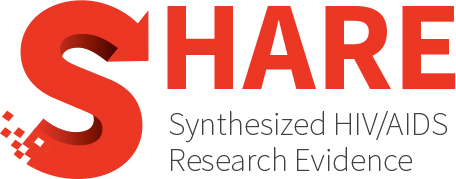Category Archives: General HIV+ population
Reviews on HIV+ people where the population is not specified
Screening and prevention of HPV-related anogenital cancers in women living with HIV in Europe: Results from a systematic review
Background Women living with HIV (WLWH) are at increased risk of human papillomavirus (HPV)-related cancers. Throughout Europe, there is great heterogeneity among guidelines for screening programmes, access to HPV testing...
Prevention of viral hepatitis and HIV infection among people who inject drugs: A systematic review and meta-analysis
This study aimed to explore the current evidence on preventing blood-borne virus infections among people who inject drugs (PWID). We conducted a comprehensive search across three databases (PubMed, Embase, Cochrane...
Syphilis epidemic among men who have sex with men: A global systematic review and meta-analysis of prevalence, incidence, and associated factors
BACKGROUND: We aimed to estimate the prevalence and incidence of syphilis at global, regional and national levels for human immunodeficiency virus (HIV)-positive and HIV-negative men who have sex with men...
Major drug resistance mutations on reverse transcriptase gene in human immunodeficiency virus type-1 in Indonesia: A systematic review
PURPOSE OF REVIEW: The prevalence of HIV-1 in Indonesia is on a concerning upward trajectory, with a concurrent rise in the development of drug-resistant strains, challenging the efficacy of antiretroviral...
Counseling supporting HIV self-testing and linkage to care among men who have se with men: Systematic review and meta-analysis
BACKGROUND: Counseling supporting HIV self-testing (HIVST) is helpful in facilitating linkage to care and promoting behavior changes among men who have sex with men (MSM). Different levels of counseling support...
Immune responses to mRNA-based vaccines given as athird COVID-19 vaccine dose in people living with HIV-a literature review
People living with HIV (PLWH) were not included in the first efficacy studies of mRNA vaccines against SARS-CoV-2. In this literature review, we investigate evidence of humoral and cellular immunity...
The cost-effectiveness of Dolutegravir in combination with Tenofovir and Lamivudine for HIV therapy: A systematic review
The World Health Organization (WHO) recommends dolutegravir (DTG), a human immunodeficiency virus (HIV) medicine, as the first- and second-line treatment for all populations because, when compared to an efavirenz (EFV)...
Weight loss and mortality in people living with HIV: A systematic review and meta-analysis
Background In the first reported cases of human immunodeficiency virus (HIV) infection, people living with HIV (PLHIV) suffered weight loss, which was an independent predictor of mortality. Highly active antiretroviral...
Patient-reported outcome measures in adult HIV care: A rapid scoping review of targeted outcomes and instruments used
Objective There is international interest in the integration of patient-reported outcome measures (PROMs) into routine HIV care, but little work has synthesized the content of published initiatives. We conducted a...
Syphilis prevalence among people living with and without HIV in sub-Saharan Africa: A systematic review and meta-analysis
BACKGROUND: Syphilis is a curable sexually transmitted infection which, untreated, is associated with significant morbidity and mortality. In people living with HIV (PLWH), syphilis carries greater risks of disease progression....
Regional variation in NAFLD prevalence and risk factors among people living with HIV in Europe: A meta-analysis
BACKGROUND AND AIM: Europe faces an elevated risk of nonalcoholic fatty liver disease (NAFLD) among people living with HIV (PLWH), contributing to the region’s highest global burden of NAFLD. However,...
Effectiveness and acceptance of group therapy as a mental health intervention for people living with HIV in Africa—A scoping literature review
Mental health problems are highly prevalent among people living with HIV/AIDS (PLWHA), yet mental health care in African countries is scarce. There is growing interest in understanding the effect of...
